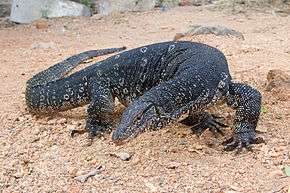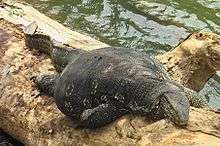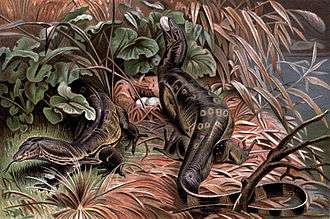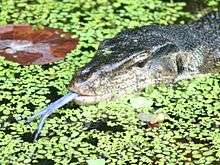Asian water monitor
- For the Australian species with similar common names, see Mertens' water monitor and Mitchell's water monitor.
| Water monitor | |
|---|---|
 | |
| Scientific classification | |
| Kingdom: | Animalia |
| Phylum: | Chordata |
| Class: | Reptilia |
| Order: | Squamata |
| Family: | Varanidae |
| Genus: | Varanus |
| Species: | V. salvator |
| Binomial name | |
| Varanus salvator (Laurenti, 1768) | |
The water monitor (Varanus salvator) is a large lizard native to South and Southeast Asia. Water monitors are one of the most common monitor lizards found throughout Asia, and range from Sri Lanka and India to Indochina, the Malay Peninsula, and various islands of Indonesia, living in areas close to water.
The species can survive where other large carnivores cannot, as they are cold-blooded (hence efficient). The species is known as Malayan water monitor, Asian water monitor, common water monitor, two-banded monitor, and as rice lizard, ring lizard, plain lizard and no-mark lizard, as well as simply "water monitor".[2]
Description
The water monitor is a large species of monitor lizard. Breeding maturity is attained for males when they are a relatively modest 40 cm (16 in) long and weigh 1 kg (2.2 lb), and for females at 50 cm (20 in). However, they grow much larger throughout life, with males being larger than females.[3] Adults rarely exceed 1.5–2 m (4.9–6.6 ft) in length,[4] but the largest specimen on record, from Sri Lanka, measured 3.21 m (10.5 ft). A common mature weight of V. salvator can be 19.5 kg (43 lb).[3][5] However, 80 males killed for the leather trade in Sumatra averaged only 3.42 kg (7.5 lb) and 56.6 cm (22.3 in) snout-to-vent and 142 cm (56 in) in total length; 42 females averaged only 3.52 kg (7.8 lb) and 59 cm (23 in) snout-to-vent and 149.6 cm (58.9 in) in total length,[6] although unskinned outsized specimens weighed 16 to 20 kg (35 to 44 lb). Another study from the same area by the same authors similarly estimated mean body mass for mature specimens at 20 kg (44 lb)[7] while yet another study found a series of adults to weigh 7.6 kg (17 lb).[8] The maximum weight of the species is over 50 kg (110 lb).[9] In exceptional cases, the species has been reported to attain 75 to 90 kg (165 to 198 lb), though most such reports are unverified and may be unreliable. They are the world's second-heaviest lizard, after the Komodo dragon.[6][10] Their bodies are muscular, with long, powerful, laterally compressed tails.

Etymology
The generic name Varanus is derived from the Arabic waral (ورل), which translates as "monitor". The specific name is the Latin word for "saviour", denoting a possible religious connotation.[11] The water monitor is occasionally confused with the crocodile monitor (V. salvadorii) because of their similar scientific names.[12]
In Thailand, the local word for a water monitor, hia (เหี้ย), is used as an insulting word for bad and evil things, including bad persons. The word is also thought to bring bad luck, so some people prefer to call the animals 'silver-and-gold' (ตัวเงินตัวทอง) to avoid the jinx.
The origin of this offensive meaning can be traced back to a time when more people lived in rural areas in close proximity to monitor lizards. Traditionally, Thai villagers lived in two-story houses; the top floor was for living, while the ground floor was designed to be a space for domestic animals such as pigs, chickens, and dogs. Water monitors would enter the ground floor and eat or maim the domestic animals, also hence the other name dtua gin gai (ตัวกินไก่ ‘chicken eater’).
In Indonesian and Malay, the water monitor is called biawak air,[13] to differentiate it from the biawak pasir ("sand lizard"), Leiolepis belliana.[14]

Subspecies
- The Asian water monitor, V. s. salvator, the nominate subspecies, is now restricted to Sri Lanka, where it is known as the kabaragoya (කබරගොයා) in Sinhala and kalawathan in Tamil.
- The Andaman Islands water monitor, V. s. andamanensis, is found on the Andaman Islands; the type locality is Port Blair, Andaman Islands.
- The two-striped water monitor, V. s. bivittatus, is common to Java, Bali, Lombok, Sumbawa, Flores, Ombai (Alor), Wetar, and some neighbouring islands within the Sunda arch, Indonesia; the type locality is Java (designated by Mertens 1959).
- The black water monitor, V. s. komaini, from Thailand (type locality: Amphoe La-ngu, Satun Prov., Thailand, and Thai-Malaysian border area), was formerly a subspecies, but now is regarded as a synonym of V. s. macromaculatus.[15]
- The Southeast Asian water monitor, V. s. macromaculatus (type locality: Siam [Thailand]), is found in mainland Southeast Asia, Singapore, Sumatra, Borneo, and smaller associated offshore islands.[15]
- Ziegler's water monitor, V. s. ziegleri, is from Obi Island.
- Varanus cumingi, Varanus marmoratus, and Varanus nuchalis were classified as subspecies until 2007, when they were elevated to full species.[15][16]
Behavior and diet

Water monitors defend themselves using their tails, claws, and jaws. They are excellent swimmers, using the raised fin on their tails to steer through water. They are carnivores, and have a wide range of foods. They are known to eat fish, frogs, rodents, birds, crabs, and snakes.[11] They have also been known to eat turtles, as well as young crocodiles and crocodile eggs.[17] Like the Komodo dragon, they will often eat carrion.[11] Water monitors have been observed eating catfish in a fashion similar to a mammalian carnivore, tearing off chunks of meat with their sharp teeth while holding it with their fore legs and then separating different parts of the fish for sequential consumption.[18]
Conservation
In Nepal it is a protected species in Chitwan National Park under the Wild Animals Protection Act of 2002. In Hong Kong, it is a protected species under Wild Animals Protection Ordinance Cap 170. In Malaysia, this species is one of the most common wild animals around, with numbers comparable to that of the population of macaques there. Although many fall prey to humans via roadkill and animal cruelty, they still thrive in most states of Malaysia, especially in the shrubs of the east-coast states such as Pahang and Terengganu. In the east-coast states of Malaysia, this species is very common in roadkill. In Thailand, all monitor lizards are protected species.[19] This monitor is exploited by the pet trade.[19]
They are hunted for their skins, with as many as 1.5 million skins being exported per year to Europe, U.S., Japan for use in fashion goods. They are also eaten. Loss of habitat and hunting has exterminated water monitors from most of mainland India. In other areas they survive despite being hunted, in part as larger ones, including large females that breed large numbers of eggs, have tough skins that are not desirable.[2]
In Sri Lanka, they are protected by locals who value their predation of "crabs that would otherwise undermine the banks of rice fields".[2]
Gallery




References
- ↑ Bennett, D., Gaulke, M., Pianka, E. R., Somaweera, R. & Sweet, S. S. (2010). "Varanus salvator". IUCN Red List of Threatened Species. Version 2014.2. International Union for Conservation of Nature. Retrieved 2014-08-26.
- 1 2 3 Ria Tan (2001). "Mangrove and wetland wildlife at Sungei Buloh Wetlands Reserve: Malayan Water Monitor Lizard". Naturia.per.sg. Retrieved 2015-09-15.
- 1 2 Shine, R.; Harlow, P. S.; Keogh, J. S. (1996). "Commercial harvesting of giant lizards: The biology of water monitors Varanus salvator in southern Sumatra". Biological Conservation 77 (2-3): 125–134. doi:10.1016/0006-3207(96)00008-0. Retrieved 2013-06-09.
- ↑ Pianka, King & king. Varanoid lizards of the world. 2004
- ↑ Water Monitor Lizard (Varanus salvator) at Pak Lah’s House | Mutakhir. Wildlife.gov.my (2012-02-23). Retrieved on 2012-08-22.
- 1 2 Shine, R., Harlow, P. S., & Keogh, J. S. (1996). Commercial harvesting of giant lizards: The biology of water monitors Varanus salvator in southern Sumatra. Biological Conservation, 77(2), 125-134.
- ↑ Shine, R., & Harlow, P. S. (1998). Ecological traits of commercially harvested water monitors, Varanus salvator, in northern Sumatra. Wildlife Research, 25(4), 437-447.
- ↑ Dryden, G. L.; Green, B.; Wikramanayake, E. D.; Dryden, K. G. (1992-02-03). "Energy and water turnover in two tropical varanid lizards, Varanus bengalensis and V. salvator". Copeia 1992 (1): 102–107. doi:10.2307/1446540.
- ↑ Water Monitor – Varanus salvator : WAZA : World Association of Zoos and Aquariums. WAZA. Retrieved on 2012-08-22.
- ↑ Wood, Gerald (1983). The Guinness Book of Animal Facts and Feats. ISBN 978-0-85112-235-9.
- 1 2 3 Robert George Sprackland (1992). Giant lizards. Neptune, NJ: T.F.H. Publications. ISBN 0-86622-634-6.
- ↑ Netherton, John; Badger, David P. (2002). Lizards: A Natural History of Some Uncommon Creatures—Extraordinary Chameleons, Iguanas, Geckos, and More. Stillwater, MN: Voyageur Press. pp. 140–141. ISBN 0-7603-2579-0.
- ↑ Journal of Bioscience, Volumes 15-16 Universiti Sains Malaysia, 2004
- ↑ The Hope Reports, Volume 4 private circulation, 1903
- 1 2 3 Koch, A., M. Auliya, A. Schmitz, U. Kuch & W. Böhme. (2007). Morphological Studies on the Systematics of South East Asian Water Monitors (Varanus salvator Complex): Nominotypic Populations and Taxonomic Overview. pp. 109–180. In Horn, H.-G., W. Böhme & U. Krebs (eds.), Advances in Monitor Research III. Mertensiella 16, Rheinbach.
- ↑ "Soterosaurus: Mindanao Water Monitor". monitor-lizards.net. Retrieved 20 March 2012.
- ↑ Whitaker, Rom (1981) "Bangladesh – Monitors and turtles". Hamadryad. 6 (3): 7–9
- ↑ Stanner, Michael (2010). "Mammal-like Feeding Behavior of Varanus salvator and its Conservational Implications" (PDF). Biawak 4 (4): 128–131.
- 1 2 Komsorn Lauprasert and Kumthorn Thirakhupt (August 2001). "Species Diversity, Distribution and Proposed Status of Monitor Lizards (Family Varanidae) in Southern Thailand" (PDF). The Natural History Journal of Chulalongkorn University (Chulalongkorn University) 1 (1): 39–46. Retrieved 2015-01-26.
Further reading
- Das, Indraneil 1988 New evidence of the occurrence of water monitor (Varanus salvator) in Meghalaya J. Bombay Nat. Hist. Soc. 86: 253–255
- Deraniyagala, P. E. P. 1944 Four New Races of the Kabaragoya Lizard Varanus salvator. Spolia Zeylanica 24: 59–62
- Pandav, Bivash 1993 A preliminary survey of the water monitor (Varanus salvator) in Bhitarkanika Wildlife Sanctuary, Orissa Hamadryad 18: 49–51
External links
-
 Media related to Varanus salvator at Wikimedia Commons
Media related to Varanus salvator at Wikimedia Commons - Animal Diversity Web
- JCVI.org
- The New Reptile Database
- Photos – Water Monitor Swimming
| ||||||||||||||||||||||||||||||||||||||||||||||
